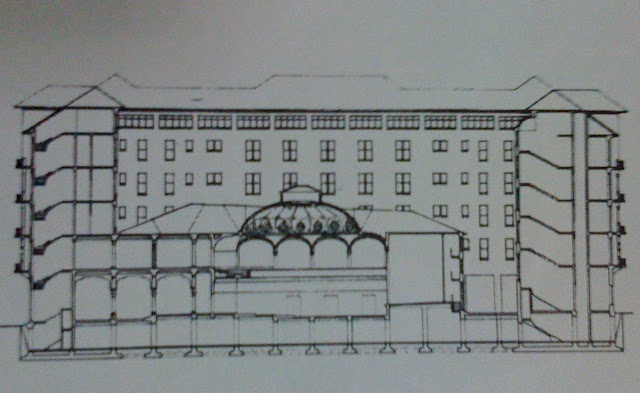 Architect: A. Kemaleddin Bey
Architect: A. Kemaleddin BeyWas built by General Directorate of Foundations, between the years 1928-1930; with the purpose of providing income with rent money. This majestic building is consist of four floors and a roof extending over the ground floor, where the stores were situated. The most significant characteristic of the ground floor of this rectangular building is a theater towering to first floor. Starting from the second floor, rooms tend to face the courtyard in the middle.
Sections without balconies on the longer face and section next to the main corner balcony were put forward and covered with wide-canopy roofs in order to give the impression of tower of First National Architecture Period. Contradicting with this feature, curves of the corner balconies’ banisters and the windows’ shapes being so simple, stands out as the elements that assort the building from National Style.
Use of arches were seen only as connectors of ground floor’s buttresses. The structure, which has concrete framework, has precise ashlar as covering.
This building was one of the first two theater buildings in Ankara. This one was the smaller one and it is also known as the Small Theater Building.
Ground Floor Plan:
Upper Floor Plan:
Section Drawing:
Free-Hand Sketch:
Photographs:
Location of the Building:
Mimar Kemaleddin (1870-1927)
Turkish architect, considered as one of the best representatives of I. National Architecture Movement, which developed in the last years of the Empire and effected first ten years of Republic period. Completed his education in the School of Engineering between the years 1887-1891, where he payed attention to Jachmund’s architecture lessons more than engineering. After graduating, he became the assistant of Jachmund’s, who had great impacts on him.
Comparing Western architecture with Ottoman’s and considering nationalist trends, he formed a new nationalist architecture as a synthesis of old forms and new methods.
His most effective years can be seen as the ten year period between 1909 and 1919. With the effects of the political situation in the Empire, an innovational period started and as a result of it, he played a big part of countless restoration works such as Sultan Ahmed and Ayasofya mosques’ repairments. Also in that period, he became a member of British Royal Architecture Institute as a result of his successful works at Jerusalem.
With Ankara being the capital of the new state, there emerged countless needs as architecture. One of them, Ankara Palace had problems at the construction stage so he was asked to contribute finding solutions and came to Ankara. After many works in Ankara, for state, his Gazi School project, that built after his death, became the end of I. National Architecture Period.
Some of his important works could not be made as a consequence of war, yet some of them were completed after Republic.








